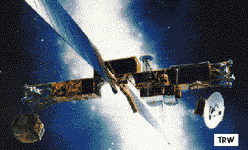Milstar
 Milstar is a series of advanced US military communications satellites designed to provide global jam-resistant communications for military users. The Milstar system, when complete, will consist of four Block 2 satellites in low-inclination, geosynchronous orbits. The operational system will accommodate direct links to numerous, highly mobile Milstar ground terminals installed on vehicles, ships, submarines and aircraft. The first two Block 1 spacecraft, launched in 1995, will eventually be replaced by the Block 2 Milstar 3 through 6, which are scheduled for launch beginning in 1999. When the full Block 2 constellation is deployed, as many as 10,000 users will be able to access the system at any given time.
Milstar is a series of advanced US military communications satellites designed to provide global jam-resistant communications for military users. The Milstar system, when complete, will consist of four Block 2 satellites in low-inclination, geosynchronous orbits. The operational system will accommodate direct links to numerous, highly mobile Milstar ground terminals installed on vehicles, ships, submarines and aircraft. The first two Block 1 spacecraft, launched in 1995, will eventually be replaced by the Block 2 Milstar 3 through 6, which are scheduled for launch beginning in 1999. When the full Block 2 constellation is deployed, as many as 10,000 users will be able to access the system at any given time.
Spacecraft
3-axis stabilized. Two large solar arrays. The second spacecraft (F2) carries 398 kg of ballast to replace a classified payload which was removed. These satellites have costly nuclear hardness and survivability features which will not be included in the four Block 2 satellites. Two crosslink dish antennas located at opposite ends of each spacecraft will connect all four Block 2 satellites to form a secure constellation that can be controlled from a single fixed or mobile control station. Crosslink operations are performed at or near frequencies that are absorbed by Earth's atmosphere, preventing detection by Earth-based ground stations. The satellite and ground station designs also incorporate advanced signal processing/encryption technologies to deny access of downlinked signals to unauthorized users.
Payload
Low data rate (LDR) EHF payload is built by TRW and has 192 channels with rates between 75 and 2400 bps. Block 2 spacecraft will carry the LDR in addition to a Medium Data Rate (MDR) payload built by Hughes. The MDR will provide rates of 4800 bps to 1.544 Mbps per channel. The MDR payload also includes two nulling spot antennas that can identify and pinpoint the location of a jammer and electronically isolate its signal, allowing Milstar users to operate normally and at full capacity with no loss in signal quality or speed, despite any attempt by hostile forces to jam or intercept its signal.
| Country of Origin | United States |
| Customer/User | USAF |
| Manufacturer(s) | Lockheed, Hughes, TRW |
| Size | Bus ~12 m long |
| Orbit | Geosynchronous |
| Design Life | 10 years |
Launch Facts
| Name | Int'l Desig. | Date | Site | Vehicle | Orbit | Mass(kg) |
| Notes | ||||||
| Milstar 1 | 1994-009A | 2/7/94 | ESMC | Titan 4 | GEO | 4500 |
| Milstar 2 (USA 115) | 1995-060A | 11/6/95 | ESMC | Titan 4 | GEO | 4500 |
| Secure military communication; 4 deg E | ||||||
Information in The Mission and Spacecraft Library is provided without warranty or guarantee. USE AT YOUR OWN RISK.